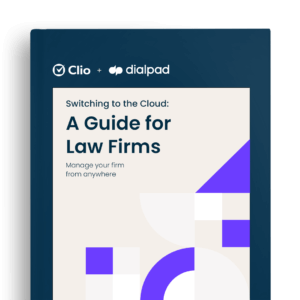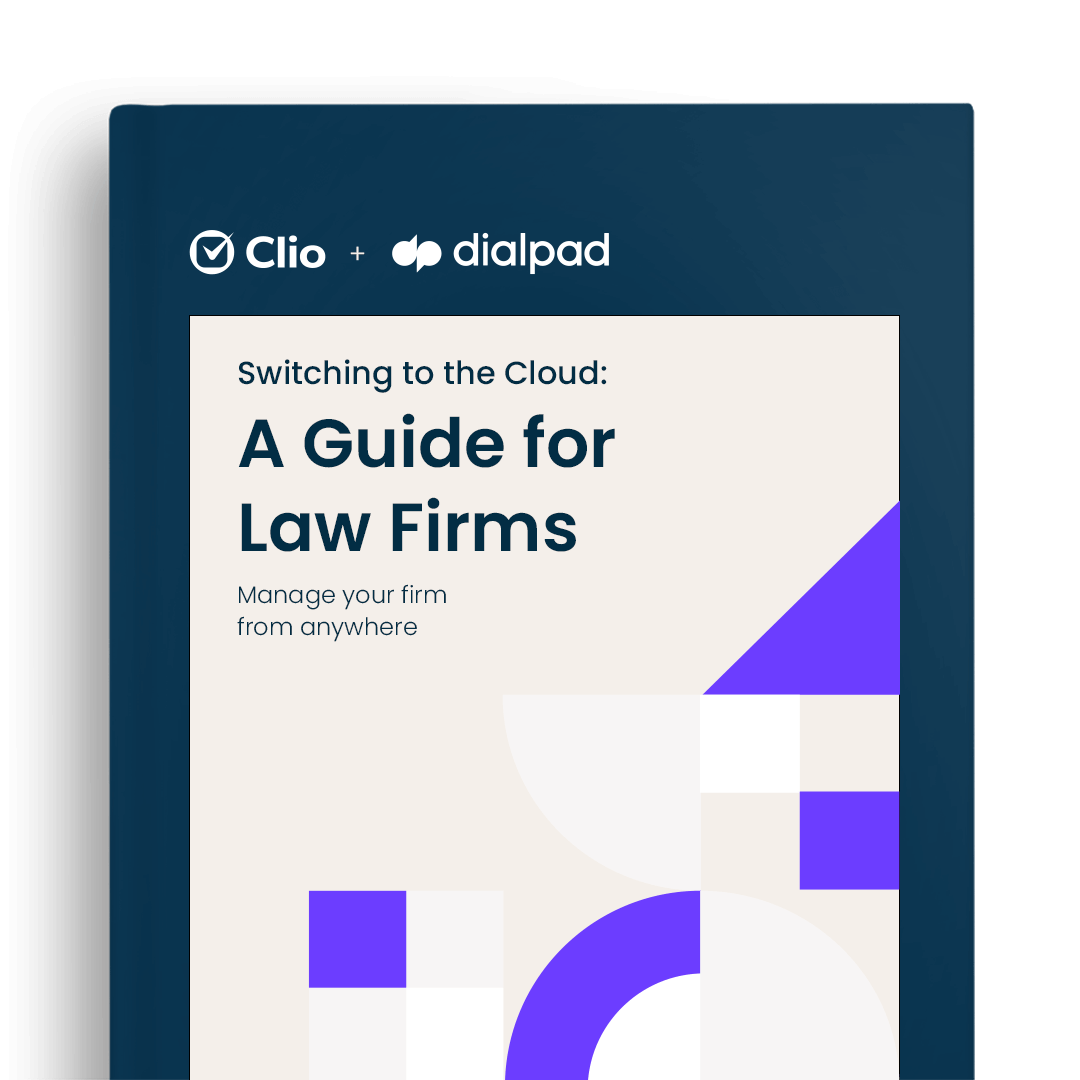Conflicts of interest for lawyers are a really big deal. We know this because we learn as much in law school—the ethics courses and Multistate Professional Responsibility Exam (MPRE) beat the concept to death. Now, we have to sit through CLEs on it every few years. That’s why it’s so important to have a conflict check process in place at your law firm.
What is a conflict check at a law firm?

Basically, conflict of interest rules state that you can’t represent a client whose interests are adverse to your own or to a former client. It doesn’t sound particularly complicated, but there are multiple American Bar Association (ABA) Model Rules dedicated to the concept, including a list of prohibitions that might as well be titled, “Don’t be like these lawyers!”
Note: Don’t risk being “that lawyer” caught in conflicts of interest. Leverage Clio Manage, the leading legal practice management software, to effectively manage and track all relevant matters and client information to stay on top of conflicts. Schedule a free Clio demo today and get a personalized tour of how it can help keep your firm compliant and organized.
Some lawyers say that the worst thing to happen if you botch a conflict check is that you find out too late. At that point, either someone else takes over the case, or you convince the affected clients to sign waivers. That’s probably true in most cases. In others, the delay in swapping out counsel or chasing conflict waivers can harm your client (consider a client waiting on a payoff in an injury case or with an upcoming statute of limitations deadline).
Besides, there’s the appearance of impropriety. These days, that’s enough to get your name plastered all over the internet by an angry former client bitter about you representing his ex-spouse in a new matter. You don’t want to deal with that. An attorney conflict check software will help you spot the issue and prepare before you’re surprised with bar complaints and internet reviews.
What counts as a law firm conflict of interest?

There are many types of lawyer misconduct, and they’ve occurred at such a frequency that formal rules have been created. Here’s a list of potential conflicts of interest a lawyer may encounter:
- Representing two clients whose interests oppose each other (e.g. Co-defendants in a criminal case who might want to snitch on each other).
- Taking on a client where your abilities to lawyer are limited due to responsibilities to a current, former, or third person (personal interest of the lawyer).
- If you represent the opposing party in the same matter after dropping a client.
- Representing a party when your former firm represented the other side and you were exposed to information about the case.
- Entering into a business transaction with a client or ownership/pecuniary position opposite to the interests of your client.
- Using information gained when representing a client to harm that client.
- Soliciting a gift—including a testamentary gift—from a client, unless the lawyer is closely related to the client.
- Securing the movie or literary rights to the client’s story, at least until the case is done.
- Providing financial assistance to a client in connection with the pending litigation, with limited exceptions for advancing costs (repayment contingent on case outcome) or covering costs for indigent clients.
- Letting a third-party pay the bill, unless the client gives consent, the lawyer’s judgment isn’t swayed, and client privacy is maintained.
- Negotiating aggregated civil settlements or criminal pleas for multiple clients.
- Making an agreement prospectively limiting malpractice liability.
- Settling a malpractice claim with an unrepresented party unless that person is given the opportunity and written advice to seek counsel.
All of the above applies to every attorney in your law firm.
That’s a lot to consider, right? And I simplified the rules for the sake of this article. There’s a lot more, plus notes, in ABA Model Rules 1.7, 1.8 and 1.9.
There are many ways to run into conflict with your client, and as you’ll note from the above list, many can be spotted at the outset of a case. This is the point of a law firm conflict check. It’s to spot and deal with these issues before signing a client and potentially running into trouble.
What’s the remedy to these conflicts of interest? For nearly all of them, informed consent suffices. Best practice, if you must take the case, is to give them the opportunity, in writing, to retain counsel regarding the potential conflict. Both the former client and current client must consent.
A better remedy, assuming the client has other options for counsel, is to not take the case on at all. Write a non-engagement letter clearly explaining that you are not taking on the case, and that the potential client needs to look elsewhere. If you know about a statute of limitations or other pressing issue, including a warning to that effect is a good practice as well.
You may like these posts
Common mistakes with law firm conflict checks

The most common mistake with a law firm conflict check is simply not doing it. A lot of attorneys rely on memory. This is obviously a bad idea. Names change, memories fade, and if you do any volume work at all, you’ll lose track of the people you talked to last week, let alone from years’ prior.
Another common misstep is to maintain inadequate records. Many attorneys maintain a simple list of their own former clients. However, usually not of associated parties, opposing parties, or the contacts of fellow attorneys in their current and former places of employment.
(A great way to avoid mistakes with conflict of interest checks is to use a practice management system like Clio to keep track of all relevant matters and client information to for you to help stay on top of conflicts. Try Clio for free today.)
Creating a conflict check process at your law firm
The starting point for a law firm conflict check is to maintain a database of all relevant contacts. This means former clients, opposing parties, etc. Here’s a list of things you should track for accurate conflict checking:
- Full legal name;
- Maiden and married names;
- Nickname(s);
- Date of birth;
- Address;
- Phone;
For businesses, you’ll want to include:
- Business name;
- Officers and directors;
- Partners;
- Trade names;
- Place of incorporation
Not all of this information will change over time. If you come across a close match, at least you can cross-reference birth dates, maiden names, etc. that require further investigation.
A conflict of interest check should be done before a consult is scheduled. If, like me, you do a lot of phone consults, whomever at your law firm first answers the phone should run the above information through your database. You’ll want to check the potential client and opposing party for close matches, misspellings (John, Jon, Johnathan, Jonathan), and former names. Once the check is complete, record the results of the check, including the date and time the check was done.
If a conflict is flagged, or even suspected, the person answering the phone can schedule a follow-up call with the attorney to discuss the matter. Indicate that the firm has time to investigate (and to evaluate whether the case is worth dealing with conflict waivers).
How long does a conflict check take?
The time it takes to properly conduct a thorough conflict check varies depending on a number of factors such as the complexity and comprehensiveness of your law firm’s database and the specific conflict-checking system you use. Using a manual process, a conflict check could take hours. With the help of tools and technology, however, conflict checks can be completed in minutes or even seconds (more on this later).
Using technology to help with law firm conflict checks

In the old days, folks would tell young lawyers to break out three binders, or three stacks of notecards, and track clients, opposing parties, and associated contacts in the three respective places. That sounds a bit like sending a telegraph, or tapping out a 30-page memo on a typewriter.
These days, you will probably use technology to help maintain a database of contacts and conduct an attorney conflict check. Here are a few tools that can help with the conflict checking process.
Spreadsheets
The most common method, I’d suspect, and the one a few firms I’ve worked with use, is an Excel spreadsheet filled with contacts. Things such as name, address, phone, date of birth, relationship to the firm, former names, etc. are recorded. Do a simple “CTRL+F” or “CMD+F” and start typing in variants of names, nicknames, etc. Make a note in the file or intake notes that a conflict check was run, who ran it, and what date and time it was completed.
The biggest downside of this is that Excel can bog down hard when you have a few attorneys with hundreds of former clients, and there’s tons of room for human error. Personally, we’d routinely freeze our PCs doing a simple search.
Practice management solutions
For Clio Manage customers, there is a built-in search function at the top of the practice management suite. So long as you have entered the relevant information into the client and matter fields, and created related contacts for opposing and other parties, searches of just a few characters should pull up relevant results.
Also, if you’re on Clio’s Advanced and Complete plans, you’ll be able to search for text within documents and their meta descriptions, adding extra peace of mind.
Conflict check software
You can also use tech tools that are specifically designed to make the conflict-check process faster, easier, and more accurate.
How can a conflict check software help you save time?
Legal conflict check software automates the process of cross-referencing clients and matter details against your database so that your firm can then easily address any potential areas of conflict that are detected. By automatically taking care of this time-consuming part of the process and helping to identify possible conflicts of interest, conflict check software speeds up the overall process while reducing the chance of manual error.
Take Faster Suite, a Clio Manage integration, for example.
Faster Suite has a feature that, with the click of a button and a few search terms, will run a conflict check. Faster Suite’s built-in Conflict Check tool will search your data in Clio—like contacts, matters, matter notes, billing records, and anything else you specify—for your specified search terms and generate a report. This is my personal favorite because it turns a conflict check into a 30-second process. It also creates notes for me, and is so simple that pretty much anyone can do it.
There is also a dedicated list of various types of conflict checking software provided by US Legal.
Pick a law firm conflict checking system (and actually use it)
It isn’t news to lawyers that they need to have a conflict check system in place. We all heard it in law school, during bar prep, and at countless CLEs. However, more lawyers are switching firms throughout their careers. Keeping a meticulous record of who you’ve represented and any other relevant contacts is more critical than ever.
Law firm conflict checking comes down to one thing
At the heart of it, law firm conflict checking is about consistency. Whether you use a dedicated tool, spreadsheet, or even binders, make sure to update your database regularly. Be thorough with your searches, and keep a record of any conflict checking you do for each case. Your practice—and your clients—will thank you.
And of course, don’t hesitate to make it easier on yourself by putting everything into a cloud-based legal practice management solution like Clio. Book a demo today to see it in action.
Note: The information in this article only applies to US practices. This post is provided for informational purposes only. It does not constitute legal, business, or accounting advice.
What is a conflict check in a law firm?
Conflict checks identify and assess possible conflicts of interest before a law firm takes on a new client or matter. This ensures the firm doesn’t represent a client whose interests adversely impact another client that the firm already represents.
How does a law firm check for conflict of interests?
When conducting a conflict check, law firms review potential client’s information, including the parties involved, the nature of the matter, and any other relevant details. Then, they compare this information to their existing client and matters list.
Why is it important to perform a conflict check in a law firm?
Conducting a conflict check is an important part of ethical practice for lawyers. It ensures that the lawyer or firm is not placed in a position where its loyalty to one client could be compromised by its representation of another client.
When does a conflict of interest occur for an employee?
A conflict of interest occurs when an individual’s personal interests – family, friendships, financial, or social factors – could compromise his or her judgment, decisions, or actions in the workplace.
We published this blog post in October 2019. Last updated: .
Categorized in: Business
Switching to the Cloud: A Guide for Law Firms
In this in-depth guide, we’ll cover everything you need to know about switching to the cloud, including actionable strategies to make the process seamless.
Get the Guide








